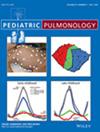整合基因组学作为儿科肺病学的临床生物标记物。
IF 2.7
3区 医学
Q1 PEDIATRICS
引用次数: 0
摘要
呼吸系统疾病往往是个体遗传易感性与暴露于各种环境和其他风险因素之间复杂的相互作用的结果。在此,我们将以哮喘和囊性纤维化为例,简要回顾各种类型的 "组学",尤其是表观基因组学和转录组学,如何有望转化为儿科肺病医学的临床生物标记物。本文章由计算机程序翻译,如有差异,请以英文原文为准。
Integrating genomics as clinical biomarkers in pediatric pulmonology.
Respiratory diseases often result from complex interactions between an individual's genetic predisposition and their exposure to various environmental and other risk factors. Here we will briefly review how various types of "omics", particularly epigenomics and transcriptomics, hold promise for translation into clinical biomarkers in pediatric pulmonary medicine, using asthma and cystic fibrosis as examples.
求助全文
通过发布文献求助,成功后即可免费获取论文全文。
去求助
来源期刊

Pediatric Pulmonology
医学-呼吸系统
CiteScore
6.00
自引率
12.90%
发文量
468
审稿时长
3-8 weeks
期刊介绍:
Pediatric Pulmonology (PPUL) is the foremost global journal studying the respiratory system in disease and in health as it develops from intrauterine life though adolescence to adulthood. Combining explicit and informative analysis of clinical as well as basic scientific research, PPUL provides a look at the many facets of respiratory system disorders in infants and children, ranging from pathological anatomy, developmental issues, and pathophysiology to infectious disease, asthma, cystic fibrosis, and airborne toxins. Focused attention is given to the reporting of diagnostic and therapeutic methods for neonates, preschool children, and adolescents, the enduring effects of childhood respiratory diseases, and newly described infectious diseases.
PPUL concentrates on subject matters of crucial interest to specialists preparing for the Pediatric Subspecialty Examinations in the United States and other countries. With its attentive coverage and extensive clinical data, this journal is a principle source for pediatricians in practice and in training and a must have for all pediatric pulmonologists.
 求助内容:
求助内容: 应助结果提醒方式:
应助结果提醒方式:


